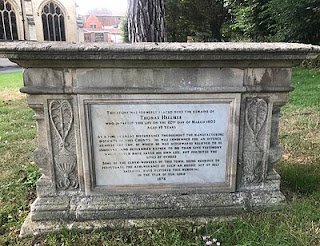It was Sober October day 15 yesterday, and I was feeling a bit cooped-up indoors, so thought I would catch the bus over to Trowbridge and have a look at the shops. I bought a fur lined hoodie type thing in Next that might be warm in the winter, and then had a mooch around a couple of charity shops until I got bored. When I got back to the bus stop, I found it was half an hour until the next bus home. How could I wile away the next 30 minutes? I remembered that I had read about a 19th century poet called George Crabbe who was rector of St James Church from 1814 to his death in 1832. I had never heard of him before, but apparently, he was very influential in his day, and Benjamin Britten had even based an opera on one of his poems. There was a memorial to him in the church.
 |
| Crabbe Memorial. |
Sacred to the memory of
Thomas Helliker
The thread of whose life was cut in the bloom
of youth. He exchanged mortality for immortality March 22, 1803, in the 19th
year of his age. The fatal catastrophe which led to this unfortunate event is
too awful to describe. Suffice it say that he met his death with the greatest
fortitude and resignation of mind. Considering his youth he may be said to have
but few equals. He died a true penitent. Being very anxious in his last moments
that others might take a timely warning and avoid evil company. This tomb was
erected at his earnest request by the cloth making factories of the counties of
York Wilts and Somerset as a token of their love to him and veneration of his
memory.
A second inscription was added later:
This tomb was formerly placed over the remains of
Thomas Helliker
At a time of great disturbance throughout the manufacturing towns of this county. He was condemned for an offence against the law of which he was afterwards believed to be innocent and determined to die rather than give testimony which would have saved his own life but forfeited the lives of others. Some of the cloth-workers of this town being so desirous to perpetuate the remembrance of such an heroic act of self-sacrifice have restored this memorial in the year of our lord 1876.
I found this fascinating, and much more interesting than George Crabbe. When I got home, I immediately looked on Wikipedia to find out more about Thomas Helliker. I discovered 'Thomas Helliker (23 March 1784 – 22 March 1803), known as The Trowbridge Martyr, was a figure in early English trade union history who was hanged, aged 19, for his alleged role in machine-breaking at a Wiltshire woollen mill. His conviction has been challenged as controversial and faulty, and he is now regarded as a victim of anti-Luddite sentiment'. He was a shearman’s apprentice, a highly skilled cutter or finisher of cloth. He worked at Littleton Mill, Semington, around 3 miles from Trowbridge. On July 22nd, 1802, a riot was organised by workers unhappy with the new machinery which threatened their livelihoods. They attacked the mill, and it was destroyed by fire. Thomas was identified as a main culprit by a man called Heath who collected £500 reward money for his dubious evidence. A man called Warren had earlier claimed he had been drinking with Thomas on the night in question, but this evidence of an alibi was not heard in court. The jury took only ten minutes to find him guilty and he was publicly hanged outside Fisherton Jail in Salisbury on March 23rd, 1803.
 |
| Last Letter. |
 |
| Annual Memorial. |












No comments:
Post a Comment